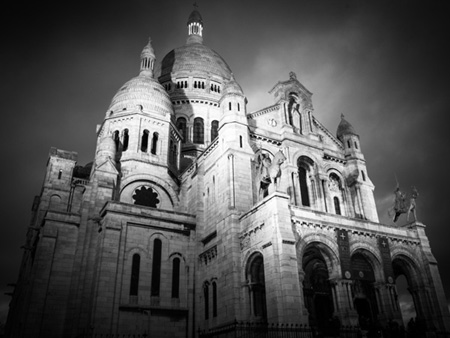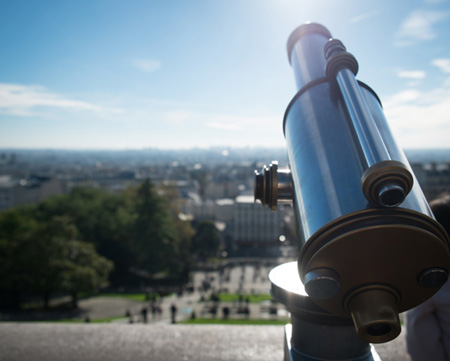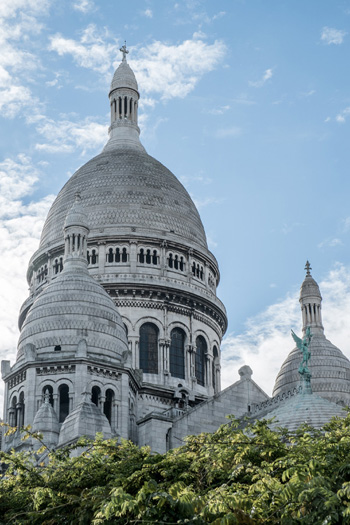Sacre Cœur and Montmartre
You may catch glimpses of the Sacre Cœur from around the city. A distinctive white building, it looks out over the city from the hill of Montmartre. Although a little farther from most of the other landmarks, the pretty streets and cafes of Montmartre, as well as the view out over the city, make it worth the effort to reach and climb the hill.

Fujifilm X-E1, 18mm, ISO 200, 4.5s, f/20
Visitor Information
Looking over the city from its highest point, the Basilique du Sacré Cœur (Basilica of the Sacred Heart) is one of the most prominent landmarks in Paris. Situated on the hill of Montmartre, the basilica is a Catholic church that was built between 1875 and 1914. Feel free to look around inside, as long as you don’t mind removing your hat and sunglasses.
You’d be hard pressed to find a richer artistic history than that of Montmartre. Salvador Dalí, Claude Monet, Pablo Picasso, and Vincent van Gogh all worked here. Today, numerous local artists draw and paint portraits for visitors at Place du Tertre, which is a short walk from the basilica.
Getting There
Montmartre is in the north part of the city, in the 18th arrondissement. The closest Metro stations to the Sacre Cœur are Anvers line 2, Abesses line 12, and Lamarck–Caulaincourt line 12. If you want to go straight to the Sacre Cœur, Anvers is the nearest station with a climb up streets and steps or via a funicular (inclined) train. If you have time, the walks from Abesses or Lamarck–Caulaincourt are less steep and provide a good way to see the area.
When to Go
Early morning is ideal to photograph the Sacre Cœur with softer light and fewer people. On a bright day, the front of the Sacre Cœur is bathed in sunlight. If the light is too harsh, try a black-and-white image. Around Montmartre, you’re likely to be taking street-style shots, so the time of day is less important than having the patience and vision to get the shot you want.
Viewpoints
As you climb the hill up to Sacre Cœur from the front, you have twin views of the church itself and the cityscape behind. Make sure you explore a bit of Montmartre, too. As you head away from Sacre Cœur and the artists’ square at Place du Tertre, fewer people will be around.
Front
The more typical photographs of Sacre Cœur are from the steps leading up to the front of the building. In addition to the normal crowds, which offer great photo ops, you might see a footballer who makes an art form out of keeping a football in the air. He is amazing to watch, and I’ve seen a few nice images of him as a silhouette against the city backdrop.
Hill
The top of the steps in front of church offers a wide panoramic view across the city. It’s often hazy, though, and more impressive to the eye than to the camera. I often look for something going on in the foreground, such as an interesting character or one of the viewing telescopes, to complement the shot.

Fujifilm X-E1, 18mm, ISO 200, 1/2400s, f/4
Parc de la Turlure
Also known as the square Marcel Bleustein-Blanchet, this small park behind the Sacre Cœur used to be the site of one of the many windmills across Montmartre. It’s ideal for portraits, with a covered walkway offering some shade. You’ll find some great views of the church from in and around the park.

Fujifilm X-E1, 44.4mm, ISO 400, 1/105s, f/16
Nearby Sights
Picasso and Van Gogh, among others, used to live and work in the streets of Montmartre. While you’re in the area, check out:
• Place du Tertre. If you head to Place du Tertre, many artists are still there, though they are much more intent on producing portraits for visitors. It’s a great place for some street photography, but you should ask the artists if they mind before you start capturing their latest work in progress.
• Moulin Rouge. If you’re coming from the Pigalle area, the Moulin Rouge theater is next to the Blanche Metro station. Don’t get your hopes up too high from watching the movie—you may be disappointed by both the building and its surroundings. The Élysées Montmartre Theatre (by the Anvers Metro station on the same street) was first opened in 1807 and is a much prettier building.
• Moulin de la Galette. Look for the converted windmill, the Moulin de la Galette, on rue Lepic. (Van Gogh used to live at house number 54.)
• Clos Montmartre Vineyard. There is a tiny but functional vineyard, the Clos Montmartre Vineyard, at rue Saint-Vincent.
• Restaurants. You can find plenty of restaurants and cafes around Montmartre, although of varying quality. Au Virage Lepic restaurant is particularly well thought of and is worth seeking out. Otherwise, just enjoy the narrow streets and quirky shops.
• Espace Dali. A museum dedicated to the work of Dalí, Espace Dali features explanatory text in English and is only a few minutes walk from Sacre Cœur.
• Streets. Of the many pretty streets around Montmartre, my favorite is the view up rue de l’Abreuvoir from Place Dalida.
